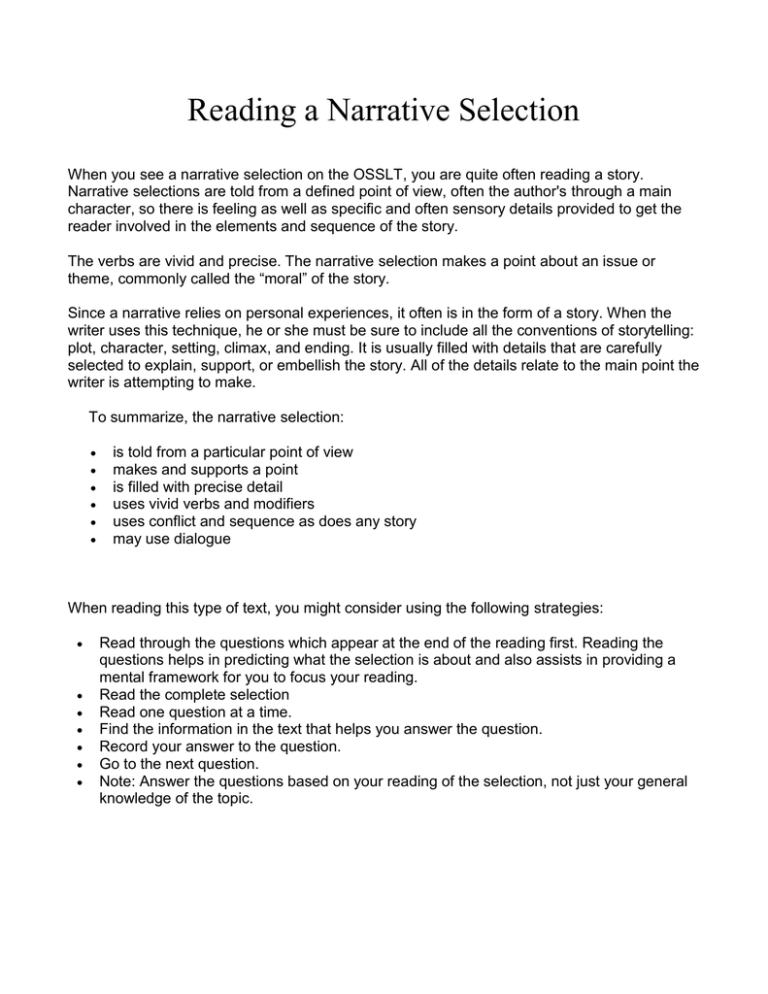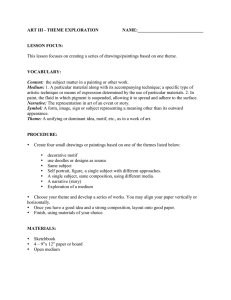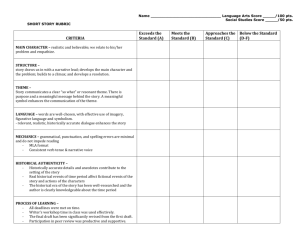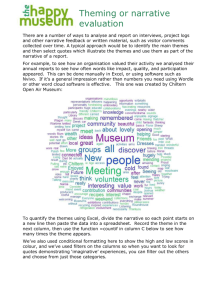Reading Narrative Selections: OSSLT Study Guide
advertisement

Reading a Narrative Selection When you see a narrative selection on the OSSLT, you are quite often reading a story. Narrative selections are told from a defined point of view, often the author's through a main character, so there is feeling as well as specific and often sensory details provided to get the reader involved in the elements and sequence of the story. The verbs are vivid and precise. The narrative selection makes a point about an issue or theme, commonly called the “moral” of the story. Since a narrative relies on personal experiences, it often is in the form of a story. When the writer uses this technique, he or she must be sure to include all the conventions of storytelling: plot, character, setting, climax, and ending. It is usually filled with details that are carefully selected to explain, support, or embellish the story. All of the details relate to the main point the writer is attempting to make. To summarize, the narrative selection: is told from a particular point of view makes and supports a point is filled with precise detail uses vivid verbs and modifiers uses conflict and sequence as does any story may use dialogue When reading this type of text, you might consider using the following strategies: Read through the questions which appear at the end of the reading first. Reading the questions helps in predicting what the selection is about and also assists in providing a mental framework for you to focus your reading. Read the complete selection Read one question at a time. Find the information in the text that helps you answer the question. Record your answer to the question. Go to the next question. Note: Answer the questions based on your reading of the selection, not just your general knowledge of the topic. To discuss or analyze short stories, you need to understand the elements of short stories which are: Be able to identify the following elements that are present in a story: 1. 2. 3. 4. 5. List and describe the main character(s). Where and when does the story take place? What is the author’s purpose in telling the story? What important things do the characters say? What is the moral of the story? Visualizing Think-Aloud Visualization is an important skill because it helps to ensure that you understand the concepts in the story. Visualization can help you to focus, remember, and apply your learning. In the column on the left indicate parts of the text that either stood out for you or parts that you had trouble understanding or visualizing. In the column on the right indicate what mind pictures emerged as you read that piece of text. Text Think-Aloud Example: Example: How one moment can change your life is amazing. This was two years ago. I’m still going to physical therapy. Oh how I wish I could take that day back. I can imagine the guy looking at himself in the mirror every day and the pain he must experience in therapy. http://resources.elearningontario.ca Most/Least Important Ideas To determine the most important idea (the theme) in a short story, organize the ideas into most important (the events and dialogue that are important in helping to communicate the theme message) AND least important (the details that make the story interesting, but do not necessarily help to communicate the theme). Most Important Ideas and Information Least Important Ideas and Information Key Idea from Passage (Theme): (write out the theme statement) http://resources.elearningontario.ca SAMPLE TIP: Quotation marks mean someone is speaking There will be a new paragraph each time a new person speaks TIP: You can tell how people feel by the use of descriptive words like: “whined”, “wailed”. TIP: Look for words that show the progression of events in the story. TIP: Words are italicized to show emphasis when someone is speaking. Answering Multiple Choice Writing Questions Before you answer multiple-choice questions, make sure you: Read each question before you look at the answers. Try to come up with the answer in your head before looking at the provided answers, this way the choices given on the test won't throw you off or trick you. Read each answer carefully; don’t skip words. Eliminate answers you know are wrong. Read over the remaining choices before choosing your answer. Choose the best or most correct answer. Which of these two words sound best and help complete the sentence? These two words don’t sound right in the sentence. When answering multiple-choice writing questions, be sure to: Read each question fully. Look for main ideas if presented with reading points. Pay attention to words that should be CAPITALIZED. Pay attention to PUNCTUATION Choose the best or most correct answer o Rule out obviously incorrect details Fill in the proper letter on the Student Answer Sheet. o Make sure you have filled in the bubble completely using pencil or blue/black pen ANSWERING MULTIPLE CHOICE WRITING QUESTIONS Think About It: This sentence focus is on raising money. The other sentences focus on Gretzky’s hockey career. Think About It: . Names, places, Titles (newspaper) are capitalized.





